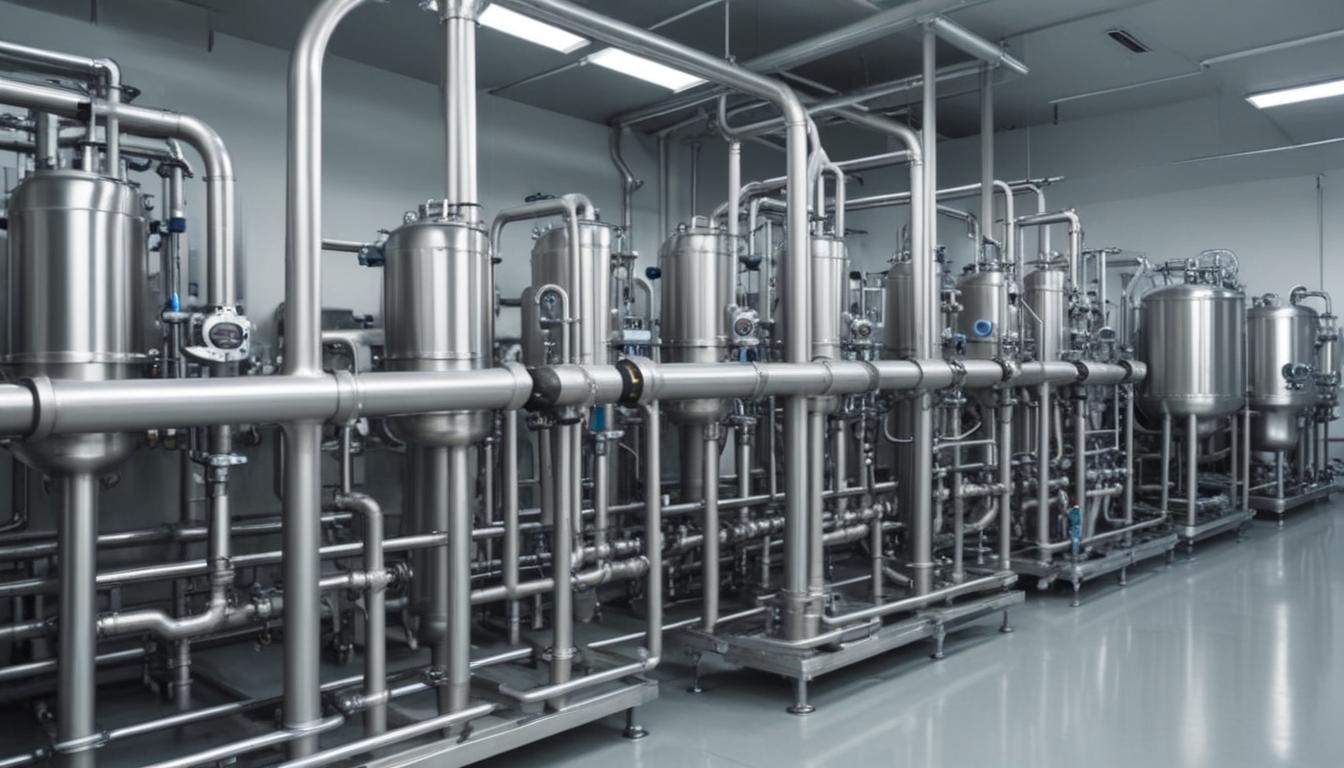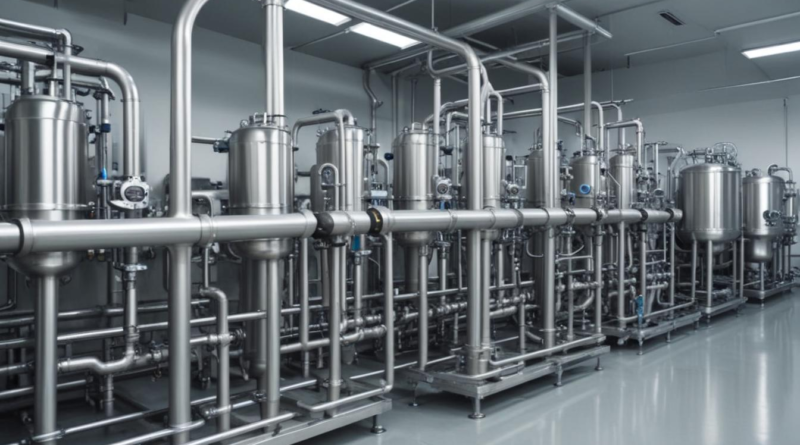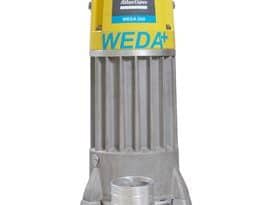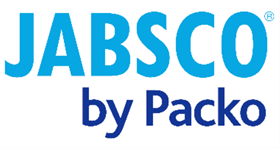pumps in the pharmaceutical manufacturing
In pharmaceutical manufacturing, the selection of the appropriate pump is essential to ensure precise and reliable processing. Various types of pumps are utilized to meet the stringent requirements of the industry, each offering unique advantages tailored to specific applications:
- Peristaltic Pumps: These pumps operate by compressing and releasing a flexible tube, creating a vacuum that moves the fluid. They are highly favored in pharma pumps for their ability to handle sterile and shear-sensitive fluids without contamination, making them ideal for applications requiring high purity.
- Diaphragm Pumps: Utilizing a reciprocating diaphragm, these pumps provide accurate and pulsation-free flow. Their capability to handle viscous and corrosive liquids makes them suitable for various manufacturing stages, including mixing and transferring active pharmaceutical ingredients (APIs).
- Gear Pumps: As positive displacement pumps, gear pumps ensure a consistent flow rate, which is crucial for precise dosing and blending processes. Their robust design allows them to handle high-viscosity fluids, making them effective in formulations requiring thick or sticky substances.
- Centrifugal Pumps: These pumps use rotational kinetic energy to move fluids, offering high flow rates and efficiency. In pharmaceutical manufacturing, centrifugal pumps are typically employed in large-scale liquid transfer and circulation systems where continuous and high-volume processing is necessary.
- Screw Pumps: Known for their ability to provide smooth and continuous flow, screw pumps are ideal for applications that demand minimal pulsation and high shear resistance. They are often used in processes involving temperature-sensitive or shear-thinning fluids.
| Type of Pump | Key Features | Common Applications |
|---|---|---|
| Peristaltic Pumps | Gentle handling, contamination-free, easy maintenance | Sterile fluid transfer, metering in liquid dosage forms |
| Diaphragm Pumps | Pulsation-free flow, handles corrosive fluids, precise control | API transfer, cleaning-in-place (CIP) systems |
| Gear Pumps | Consistent flow rate, handles high viscosity, durable | Blending, compounding, emulsification processes |
| Centrifugal Pumps | High flow rates, efficient for large volumes, continuous operation | Water circulation, large-scale liquid transfer |
| Screw Pumps | Smooth flow, minimal pulsation, high shear resistance | Temperature-sensitive formulations, shear-thinning fluids |
Each pump type offers distinct benefits tailored to specific needs within pharmaceutical manufacturing. Understanding the characteristics and optimal applications of each pump ensures efficient and compliant production processes, ultimately contributing to the quality and reliability of pharmaceutical products.
pump selection criteria
Selecting the appropriate pump for pharmaceutical manufacturing involves a meticulous evaluation of several critical factors to ensure optimal performance, reliability, and compliance with industry standards. The decision-making process must consider the following key criteria:
- Fluid Properties: Understanding the physical and chemical characteristics of the fluid is paramount. Factors such as viscosity, corrosiveness, temperature sensitivity, and the presence of particulates dictate the suitability of certain pump types. For instance, highly viscous or shear-sensitive fluids may require positive displacement pumps like gear or peristaltic pumps to maintain product integrity.
- Flow Rate and Pressure Requirements: The desired flow rate and operating pressure influence pump selection significantly. Applications demanding high flow rates and pressures might necessitate centrifugal or diaphragm pumps, while those requiring precise, low-flow measurements may be better served by peristaltic or syringe pumps.
- Compatibility with Materials: The materials of construction must be compatible with the fluids being handled to prevent contamination and ensure longevity. Pumps with stainless steel components are often preferred in pharma pumps for their resistance to corrosion and ease of sterilization.
- Sterilization and Cleanability: In pharmaceutical manufacturing, maintaining sterility is crucial. Pumps must be designed for easy cleaning and sterilization, often featuring smooth surfaces and minimal crevices to prevent microbial growth. Options like clean-in-place (CIP) compatible pumps are advantageous for reducing downtime and ensuring hygienic processing conditions.
- Accuracy and Precision: Processes such as dosing, blending, and filling require pumps that offer high accuracy and repeatability. Diaphragm and syringe pumps are typically chosen for their ability to deliver precise volumes consistently.
- Regulatory Compliance: Pumps must comply with relevant regulatory standards, including those set by the FDA, EMA, and USP pharma pumps must adhere to Good Manufacturing Practices (GMP). This includes ensuring that materials, design, and operation meet strict guidelines to maintain product quality and safety.
- Maintenance and Reliability: The ease of maintenance and the reliability of the pump are essential to minimize downtime and ensure continuous production. Pumps with modular designs and readily replaceable parts can reduce maintenance time and costs.
- Energy Efficiency: Energy consumption is a consideration, especially for large-scale manufacturing operations. Selecting energy-efficient pumps can lead to significant cost savings and reduced environmental impact over time.
A structured approach to pump selection can be facilitated using the following table, which outlines the primary criteria and their implications:
| Selection Criterion | Considerations | Implications for Pump Choice |
|---|---|---|
| Fluid Properties | Viscosity, corrosiveness, particulate matter | Positive displacement pumps for high viscosity; materials resistant to corrosive fluids |
| Flow Rate and Pressure | Required flow rate, operating pressure | Centrifugal pumps for high flow; diaphragm or syringe pumps for precise, low-flow applications |
| Material Compatibility | Chemical compatibility, material standards | Stainless steel pumps for corrosive or sterile applications |
| Sterilization Needs | Clean-in-place capabilities, sterilization methods | Designs that support CIP and aseptic processing |
| Accuracy and Precision | Volume control, repeatability | Diaphragm and syringe pumps for high precision |
| Regulatory Compliance | GMP standards, FDA/EMA guidelines | Pumps designed and certified for pharmaceutical use |
| Maintenance and Reliability | Ease of servicing, mean time between failures | Modular pumps with accessible components |
| Energy Efficiency | Power consumption, operational costs | Energy-efficient motors and drive systems |
Additionally, the following decision matrix can assist in evaluating and prioritizing these criteria based on specific manufacturing needs:
- Identify Requirements: Clearly define the process requirements, including flow rates, pressures, and fluid characteristics.
- Rank Criteria: Prioritize the selection criteria based on their importance to the specific application.
- Evaluate Options: Assess available pump types against the ranked criteria to determine the best fit.
- Consider Future Needs: Account for potential changes in production volume or fluid properties that may influence pump performance.
- Validate Selection: Conduct testing and validation to ensure the selected pump meets all operational and regulatory requirements.
By systematically evaluating these selection criteria, pharmaceutical manufacturers can ensure that the chosen pump not only meets the immediate operational demands but also aligns with long-term production goals and regulatory obligations. This comprehensive approach enhances process efficiency, product quality, and overall manufacturing effectiveness.
calibration and maintenance
Calibration and maintenance are critical aspects of ensuring the optimal performance and longevity of pumps used in pharmaceutical manufacturing. Regular calibration guarantees that pumps operate within specified parameters, maintaining the accuracy and precision necessary for high-quality pharmaceutical applications. Effective maintenance practices prevent downtime, reduce the risk of contamination, and ensure compliance with stringent regulatory standards.
Calibration involves adjusting the pump to ensure that its output aligns with the desired specifications. This process typically includes the following steps:
- Initial Baseline Calibration: Establishing a reference point by calibrating the pump against known standards before it begins regular operation.
- Scheduled Calibration: Performing periodic calibrations based on the pump’s usage, manufacturer recommendations, and regulatory requirements to ensure ongoing accuracy.
- Verification Calibration: Conducting spot checks and additional calibrations after any maintenance or unexpected shutdowns to verify that the pump continues to operate correctly.
- Documentation: Recording all calibration activities, including dates, results, and any adjustments made, to maintain traceability and compliance with Good Manufacturing Practices (GMP).
Maintenance encompasses a broader range of activities designed to keep pumps functioning efficiently and to extend their service life. Key maintenance tasks include:
- Preventative Maintenance: Regularly scheduled inspections and servicing to identify and address potential issues before they lead to pump failure. This includes cleaning, lubricating moving parts, and replacing worn components.
- Corrective Maintenance: Addressing specific problems as they arise, such as repairing leaks, replacing damaged seals, or fixing electrical issues.
- Predictive Maintenance: Utilizing data analytics and condition monitoring tools to predict when maintenance should be performed, thereby minimizing unexpected downtime and optimizing maintenance schedules.
- Component Replacement: Timely replacement of parts that have reached the end of their service life, such as diaphragms in diaphragm pumps or tubing in peristaltic pumps, to maintain performance and reliability.
- Cleaning and Sanitation: Ensuring that pumps are thoroughly cleaned and sanitized to prevent microbial contamination, especially in sterile applications.
A structured maintenance program can be visualized in the following table:
| Maintenance Type | Activities | Frequency |
|---|---|---|
| Preventative Maintenance | Inspecting components, lubricating moving parts, checking electrical connections | Monthly or as per manufacturer’s guidelines |
| Corrective Maintenance | Repairing leaks, replacing damaged seals, fixing electrical issues | As needed |
| Predictive Maintenance | Condition monitoring, vibration analysis, performance trending | Continuous or scheduled based on data insights |
| Component Replacement | Replacing diaphragms, tubing, seals, and other wear parts | Based on usage and manufacturer recommendations |
| Cleaning and Sanitation | Disassembling parts for thorough cleaning, sterilizing components | After each production batch or as required |
Implementing a comprehensive calibration and maintenance program involves several best practices:
- Develop a Maintenance Schedule: Create and adhere to a detailed maintenance calendar that includes all necessary calibration and servicing tasks, ensuring consistency and reliability.
- Train Personnel: Ensure that maintenance staff are adequately trained in pump operation, calibration techniques, and regulatory requirements to perform tasks accurately and safely.
- Use Quality Tools and Standards: Employ calibrated instruments and follow standardized procedures to maintain high levels of accuracy and consistency in all calibration and maintenance activities.
- Monitor Performance Metrics: Track key performance indicators (KPIs) such as pump uptime, failure rates, and maintenance costs to identify trends and opportunities for improvement.
- Maintain Detailed Records: Keep comprehensive logs of all calibration and maintenance activities, including dates, performed tasks, personnel involved, and any issues encountered, to ensure traceability and facilitate audits.
- Engage with Manufacturers: Collaborate with pump manufacturers for technical support, access to original parts, and updates on best practices or design improvements that can enhance pump performance and longevity.
Adhering to these practices not only ensures the reliable operation of pharma pumps but also supports compliance with regulatory bodies such as the FDA and EMA. Proper calibration and maintenance contribute to the overall efficiency of pharmaceutical manufacturing processes, reducing the risk of product recalls, ensuring consistent product quality, and optimizing operational costs. By prioritizing these activities, manufacturers can sustain high standards of production and uphold their commitment to delivering safe and effective pharmaceutical products.
regulatory compliance
 Regulatory compliance is a cornerstone of pharmaceutical manufacturing, ensuring that all processes and equipment, including pumps, meet stringent standards set by governing bodies. Adhering to these regulations not only guarantees the safety and efficacy of pharmaceutical products but also fosters trust and credibility within the industry. Key aspects of regulatory compliance for pumps in pharmaceutical manufacturing include adherence to Good Manufacturing Practices (GMP), validation processes, documentation, and audits.
Regulatory compliance is a cornerstone of pharmaceutical manufacturing, ensuring that all processes and equipment, including pumps, meet stringent standards set by governing bodies. Adhering to these regulations not only guarantees the safety and efficacy of pharmaceutical products but also fosters trust and credibility within the industry. Key aspects of regulatory compliance for pumps in pharmaceutical manufacturing include adherence to Good Manufacturing Practices (GMP), validation processes, documentation, and audits.
- Good Manufacturing Practices (GMP): GMP guidelines are critical in pharmaceutical manufacturing, providing a framework to ensure products are consistently produced and controlled according to quality standards. Pumps must be designed, maintained, and operated in compliance with GMP to prevent contamination, ensure accurate dosing, and maintain product integrity. This includes using materials that are biocompatible, easy to clean, and resistant to corrosion.
- Validation: Validation is the process of demonstrating that a pump consistently performs its intended function within specified parameters. This includes Installation Qualification (IQ), Operational Qualification (OQ), and Performance Qualification (PQ):
- Installation Qualification (IQ): Verifies that the pump is installed correctly and according to manufacturer specifications.
- Operational Qualification (OQ): Ensures that the pump operates within the defined limits under various conditions.
- Performance Qualification (PQ): Confirms that the pump consistently performs as intended during actual manufacturing processes.
- Documentation: Comprehensive documentation is essential for regulatory compliance. This includes detailed records of pump specifications, validation protocols, maintenance logs, calibration certificates, and any changes or deviations in pump operation. Proper documentation facilitates traceability, supports audits, and ensures that all regulatory requirements are met consistently.
- Audits and Inspections: Regular audits and inspections by regulatory authorities such as the FDA, EMA, and other regional bodies assess compliance with GMP and other relevant standards. Manufacturers must be prepared for these audits by maintaining up-to-date records, ensuring all processes are documented, and demonstrating adherence to regulatory guidelines.
Compliance with regulatory standards can be effectively managed through the following strategies:
| Compliance Aspect | Key Requirements | Impact on Pump Selection and Operation |
|---|---|---|
| GMP Adherence | Quality management systems, contamination control, personnel training | Selection of pumps with hygienic designs, materials suitable for cleanability, and ease of maintenance |
| Validation Processes | Installation, operational, and performance qualifications | Pump must be reliably reproducible and capable of consistent performance during qualification stages |
| Comprehensive Documentation | Detailed records of specifications, validation, maintenance, and calibrations | Pumps should support easy documentation through integrated monitoring and control systems |
| Regular Audits and Inspections | Compliance with regulatory standards, timely addressing of non-conformances | Pumps should be compliant with current regulations and adaptable to any updates or changes in standards |
Regulatory compliance also involves staying abreast of evolving standards and guidelines. Pharmaceutical manufacturers must continuously monitor updates from regulatory bodies and incorporate necessary changes into their pump operations and maintenance protocols. This proactive approach ensures ongoing compliance and minimizes the risk of non-compliance penalties.
- Training and Education: Ongoing training programs for personnel are essential to ensure that all staff understand regulatory requirements and the proper operation and maintenance of pumps. This includes training on GMP, handling deviations, and understanding validation procedures.
- Risk Management: Implementing a robust risk management strategy helps identify potential compliance issues before they arise. This includes conducting risk assessments related to pump operation, such as potential sources of contamination, mechanical failures, and process deviations.
- Continuous Improvement: Establishing a culture of continuous improvement encourages regular review and enhancement of pump-related processes. Feedback from audits, inspections, and operational data can be used to make informed decisions that enhance compliance and operational efficiency.
By prioritizing regulatory compliance, pharmaceutical manufacturers ensure that their pharma pumps consistently meet the highest standards of quality and safety. This not only safeguards the integrity of the manufacturing process but also upholds the trust of consumers and regulatory authorities alike. Effective compliance strategies contribute to the seamless integration of pumps within pharmaceutical applications, ultimately supporting the production of safe and effective pharmaceutical products.
applications in production
In pharmaceutical manufacturing, pumps play a pivotal role in various stages of the production process, ensuring the efficient and precise handling of fluids essential for producing high-quality pharmaceutical products. Their applications span across multiple facets of manufacturing, each requiring specific pump functionalities to meet stringent industry standards.
Liquid Transfer and Batching
Accurate and reliable liquid transfer is fundamental in pharmaceutical manufacturing. Pumps are utilized to move raw materials, solvents, and active pharmaceutical ingredients (APIs) between different stages of production. Precision in batching ensures that the correct quantities of each component are combined, maintaining the integrity and consistency of the final product.
- API Transfer: Diaphragm and peristaltic pumps are commonly used for transferring APIs due to their ability to handle viscous and shear-sensitive materials without contamination.
- Solvent Handling: Centrifugal pumps are preferred for moving large volumes of solvents efficiently, especially in high-flow-rate applications.
- Batching Systems: Positive displacement pumps, such as gear pumps, ensure precise metering of ingredients during the batching process, crucial for maintaining formulation accuracy.
Mixing and Blending
Effective mixing and blending are critical for ensuring uniformity in pharmaceutical formulations. Pumps facilitate the continuous or batch-wise mixing of ingredients, ensuring consistency in the dispersion of active and inactive components.
- Emulsification: Gear pumps are adept at handling high-viscosity emulsions, providing a steady and consistent flow that enhances the emulsification process.
- Solution Mixing: Peristaltic pumps offer gentle handling of sensitive solutions, preventing shear-induced degradation during the mixing process.
- Homogenization: Screw pumps provide smooth and consistent flow, which is essential for achieving homogenous mixtures in high-viscosity applications.
Dosing and Dispensing
Precision dosing and dispensing are vital for ensuring the correct dosage of active ingredients in pharmaceutical products. Pumps are employed to deliver exact volumes of liquids, maintaining the accuracy and repeatability required for regulatory compliance and product efficacy.
- Metering Pumps: Diaphragm and syringe pumps are utilized for their high accuracy and repeatability in dosing applications, crucial for precise formulation.
- Dispensing Systems: Peristaltic pumps ensure contamination-free dispensing, essential for sterile pharmaceutical products.
Filling and Packaging
The filling and packaging stages of pharmaceutical manufacturing demand pumps that can handle various viscosities and ensure sterile and accurate packaging of products, such as tablets, capsules, and liquid formulations.
- Liquid Filling: Centrifugal pumps are often used in high-speed liquid filling lines, providing the necessary flow rates and reliability for continuous production.
- Viscous Product Handling: Gear and diaphragm pumps manage the transfer of thick or sticky formulations into packaging containers, ensuring consistency and minimizing waste.
Cleaning in Place (CIP) Systems
Maintaining cleanliness and preventing cross-contamination are paramount in pharmaceutical manufacturing. Pumps are integral to CIP systems, which clean equipment without disassembly, ensuring efficiency and adherence to hygiene standards.
- Automated Cleaning: Diaphragm and centrifugal pumps circulate cleaning agents through the system, effectively removing residues and contaminants.
- Sterilization Processes: Pumps ensure the precise delivery of sterilizing solutions, maintaining the integrity of the cleaning process.
Environmental Control Systems
Pumps are essential in maintaining the environmental conditions required for pharmaceutical manufacturing, such as temperature control, water purification, and air handling systems.
- Water Systems: Centrifugal and peristaltic pumps manage the flow of purified water used in various manufacturing processes, ensuring consistent quality and availability.
- HVAC Systems: Pumps facilitate the circulation of heating, ventilation, and air conditioning fluids, maintaining optimal environmental conditions for production.
API Production
The production of active pharmaceutical ingredients involves complex chemical processes that require precise control and handling. Pumps are integral in transferring reactants, controlling reaction conditions, and ensuring the efficient synthesis of APIs.
- Chemical Feeding: Diaphragm and peristaltic pumps provide accurate dosing of reagents, crucial for maintaining reaction stoichiometry.
- Reaction Control: Screw and gear pumps manage the flow of reactants, ensuring consistent mixing and reaction conditions.
Formulation and Granulation
During formulation and granulation, pumps assist in the precise addition of liquids to powders, facilitating the formation of granules with uniform size and composition.
- Granulation Liquids: Peristaltic and diaphragm pumps ensure the accurate and consistent addition of binders and other granulating agents.
- Continuous Processes: Positive displacement pumps support continuous granulation processes by providing a steady flow of liquids necessary for granule formation.
Quality Control and Testing
Ensuring the quality of pharmaceutical products involves rigorous testing and analysis, where pumps play a role in sample preparation, reagent delivery, and maintaining flow rates in analytical instruments.
- Analytical Instrumentation: Syringe and peristaltic pumps are used in chromatography and spectrometry for the precise delivery of samples and reagents.
- Sample Handling: Diaphragm and gear pumps facilitate the movement of samples through various testing stages, ensuring accurate and reliable results.
The integration of pumps into these diverse applications underscores their indispensability in pharmaceutical manufacturing. By leveraging the specific capabilities of different pump types, manufacturers can achieve the precision, reliability, and efficiency necessary to produce high-quality pharmaceutical products that meet rigorous industry standards.



